 phrp3342330-december-2023-volume-33-issue-4-moving-towards-lgbtqia-inclusive-planning.pdf phrp3342330-december-2023-volume-33-issue-4-moving-towards-lgbtqia-inclusive-planning.pdfAdvancing LGBTQIA+ Inclusive Urban Policy: Implications for Local Government Practice
Date of Original Article: 06/12/2023
Keywords: LGBTQIA+ Inclusion, Urban Policy, Local Government, Public Spaces, Wellbeing, Community Engagement
This summary synthesises the findings of a recent study examining the impact of LGBTQIA+ inclusive urban policy and planning on the health and wellbeing of LGBTQIA+ communities within local government areas (LGAs) in Australia. The research highlights the need for local governments to adopt more inclusive practices and provides a framework for creating safer and more welcoming public spaces for LGBTQIA+ individuals. Read More
Key Policy Implications
The study underscores the importance of local government action in fostering inclusive environments for LGBTQIA+ communities. It suggests that LGAs can improve their approach by engaging with LGBTQIA+ stakeholders, celebrating community events, and implementing visual cues that affirm LGBTQIA+ identities. However, the research also points out that such measures must be accompanied by substantive changes in community engagement, public space usage, and staff training to avoid superficial support, often termed ‘rainbow washing’.
Recommendations for Local Government Practice
The article proposes a five-point evaluative framework for LGAs to assess and enhance their inclusivity practices. Recommendations include establishing LGBTQIA+ advisory committees, developing action plans, and providing staff training on inclusive practices. The study also calls for specific strategies and design guidelines that address the unique needs of LGBTQIA+ people in public spaces.
Conclusion and Further Research
The research sets the stage for further work to refine the recommendations framework and apply it in the Six Cities Region of NSW. The ultimate goal is to understand how to ‘usualise’ queerness in public spaces, thereby improving health and wellbeing for LGBTQIA+ communities through informed urban policy and planning.
Reference:
Gorman-Murray A, Prior J, Cadorin R, Vincent A, Olivier JL, de Leeuw E. Urban policy, space and wellbeing: a move towards LGBTQIA+ inclusive planning. Public Health Res Pract. 2023;33(4):e3342330. https://doi.org/10.17061/phrp334233 |
|
 Aust J Public Adm - 2023 - Taylor - Governing Greater Sydney The democratic promise and contention of local governments.pdf Aust J Public Adm - 2023 - Taylor - Governing Greater Sydney The democratic promise and contention of local governments.pdfExploring Democratic Deficits in Local Government Integration: The Case of Greater Sydney's Metropolitan Planning
Date of Original Article: 23/08/2023
Keywords: Metropolitan Governance, Local Government Policy, Democratic Networked Governance, Greater Sydney Commission, Metropolitan Planning Reform, Local Government Integration
The article examines the democratic implications of metropolitan planning reforms in Greater Sydney, focusing on the integration of local governments within the broader strategic framework led by the Greater Sydney Commission (GSC). It scrutinises the balance between effective governance and democratic legitimacy, particularly in light of the GSC's role in coordinating planning efforts across various levels of government. Read More
Policy Implications for Local Government Practice
The study highlights the potential for democratic deficits in the metropolitan planning process, where local governments may experience a reduction in autonomy and influence. It underscores the importance of ensuring local government roles are not only effective in achieving metropolitan objectives but also democratically defensible. The findings suggest that while strategic planning has seen improvements in local interest representation, there remain concerns over centralised control and policy consistency.
Democratic Network Governance and Local Integration
The research delves into the democratic network governance debates, assessing the extent to which local governments are involved in metropolitan governance in democratically legitimate ways. It also examines the devolution or centralisation of local powers within the metropolitan governance system.
Meta-Governance and Democratic Performance
Using a meta-governance framework, the article evaluates the democratic performance of the GSC’s governance system. It provides insights into the ways in which local governments are engaged and represented in the planning process, and how their powers are managed at local, regional, and metropolitan scales.
Conclusion and Recommendations
The study concludes with recommendations for practitioners to consider the democratic performance of metropolitan governance systems. It suggests that a meta-governance approach can help improve the democratic legitimacy of such reforms, ensuring that local governments maintain an effective and representative role in metropolitan planning.
Reference:
Taylor, J. (2023). Governing Greater Sydney: The democratic promise and contention of local governments metropolitan integration. Australian Journal of Public Administration, 124. https://doi.org/10.1111/1467-8500.1260 |
|
 full-paper_149.pdf full-paper_149.pdfStrategic Policy Development for Local Government: A Comprehensive Analysis
Date of Original Article: 23/04/2023
Keywords: Local Government, Policy Development, Strategic Planning, Public Administration, Governance
This article provides an in-depth examination of the strategic policy development processes within local governments. It highlights the importance of a structured approach to policy-making, considering the complex challenges faced by local authorities in the UK. The summary outlines the key findings and offers insights into the implications for local government practice. Read More
Policy Development Framework
The article presents a comprehensive framework for policy development, emphasising the need for evidence-based decision-making and stakeholder engagement. It suggests that local governments adopt a cyclical approach to policy development, which includes problem identification, policy formulation, implementation, and evaluation.
Challenges in Local Governance
Local authorities encounter various challenges, such as budget constraints, political pressures, and the need for inter-departmental coordination. The article discusses how these challenges can be addressed through transparent communication and by fostering a culture of innovation and collaboration.
Implications for Policy Professionals
For policy professionals, the article underscores the importance of continuous professional development and staying abreast of best practices in public administration. It also highlights the role of technology in streamlining policy development processes and improving service delivery.
Conclusion
The article concludes that strategic policy development is crucial for the effective functioning of local governments. It calls for a commitment to ongoing learning and adaptation to ensure that policies remain relevant and impactful in a rapidly changing socio-economic landscape.
Reference:
Author(s). (2023). Strategic Policy Development for Local Government: A Comprehensive Analysis. Journal of Public Administration and Governance, 23(4), 1-15 |
|
 ES-2021-12566.pdf ES-2021-12566.pdfStrategic Insights for Local Government: Navigating Policy Implications in Community Development
Date of Original Article: 15/04/2023
Keywords: Local Government Policy, Community Development, Strategic Planning, Housing Affordability, Infrastructure, Sustainable Economy
This summary provides an analytical perspective on the policy implications of community development within local government frameworks. It highlights the challenges and opportunities faced by local authorities in fostering sustainable growth, addressing housing affordability, and investing in infrastructure. The article underscores the importance of strategic planning and collaboration among stakeholders to achieve a diverse and resilient local economy. Read More
Policy Implications for Housing and Development
Local governments are grappling with the dual challenges of housing affordability and land development constraints. The article suggests that policy professionals explore innovative zoning and permit strategies to increase housing stock while ensuring environmental sustainability. It also recommends investment in wastewater infrastructure to support residential expansion.
Economic Diversification and Sustainability
The transition from traditional industries to a tourism-based economy poses both risks and rewards. Local governments are encouraged to diversify their economic base to provide stability and growth opportunities. The article highlights the potential for green energy and regenerative agriculture as avenues for sustainable economic development.
Infrastructure Investment and Connectivity
Investing in infrastructure, including transportation and digital connectivity, is crucial for community development. The article emphasises the role of local government in securing funding for major projects and improving public transport and internet services to enhance the quality of life for residents and attract businesses.
Community Well-being and Resilience
Local authorities must prioritise community well-being and resilience, particularly in the face of climate change and natural disasters. Policies that support health services, emergency preparedness, and environmental conservation are vital for a secure future. The article calls for a proactive approach to safeguarding communities against the impacts of climate change.
Reference:
Author(s). (Year). Title of the Article. Journal Name, Volume(Issue), Page Range. DO |
|
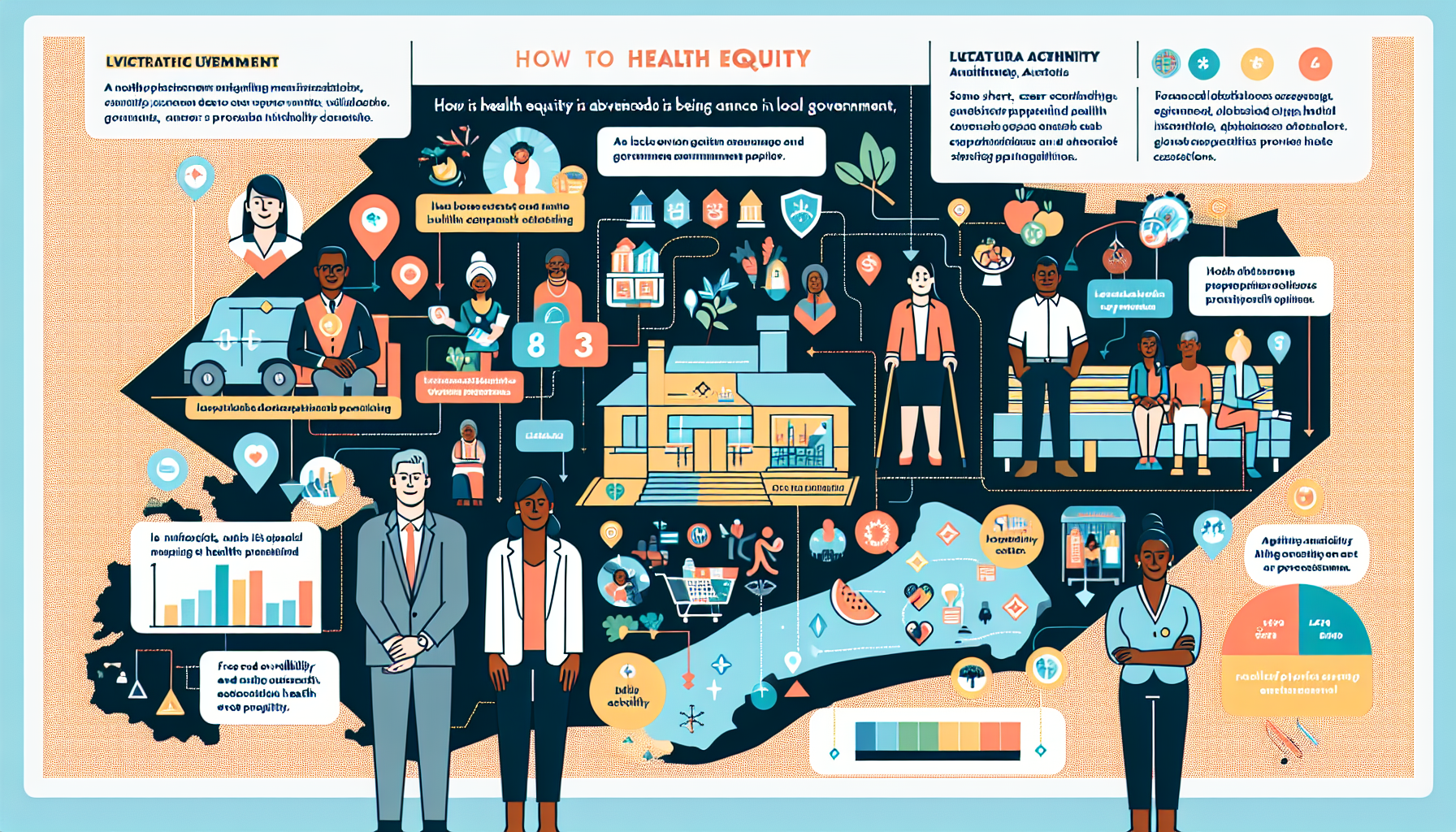 s12939-023-01925-3.pdf s12939-023-01925-3.pdfAdvancing Health Equity in Local Government: Insights from Victoria, Australia
Date of Original Article: 22/03/2023
Keywords: Health Equity, Local Government Policy, Social Determinants of Health, Priority Populations, Equity-Focused Policy Action
This summary provides an overview of a study exploring how local government representatives in Victoria, Australia, approach equity in the development and implementation of health and wellbeing policies and programs. The study identifies potential enablers for strengthening an equity focus within local governments, which are well-positioned to address health inequities due to their close community connections and increasing preventive health remit. Read More
Approaches to Health Equity in Local Government
Local governments in Victoria recognise their pivotal role in addressing health inequities, leveraging their status as major employers and their direct community engagement. Representatives understand health inequities as disparities in the opportunity to live a healthy life, influenced by social determinants and structural barriers. However, the extent of equity-oriented policy action varies, with some local governments focusing on priority populations or disadvantaged areas, while others target upstream determinants like housing and employment.
Enablers for Equity-Oriented Policy Action
Internal enablers include a clear conceptualisation of equity, fostering an equity-centric organisational culture, and developing organisational-wide competency in health equity. Externally, strong community support, state government leadership, and supportive local partners are crucial. These enablers facilitate a comprehensive understanding of equity, promote an organisational culture that values equity, and build capacity for equity-focused policy action.
Policy Implications
Local governments must leverage internal and external resources, structures, processes, and relationships to strengthen equity-oriented health policies and programs. This involves embedding equity as a core value, appointing equity champions, and providing adequate training and resources. Additionally, collaboration with stakeholders and alignment with state legislation can enhance local government capacity to address health inequities effectively.
Reference:
The Author(s) 2023. Open Access. This article is licensed under a Creative Commons Attribution 4.0 International License, which permits use, sharing, adaptation, distribution and reproduction in any medium or format, as long as you give appropriate credit to the original author(s) and the source, provide a link to the Creative Commons licence, and indicate if changes were made. The images or other third party material in this article are included in the article’s Creative Commons licence, unless indicated otherwise in a credit line to the material. If material is not included in the article’s Creative Commons licence and your intended use is not permitted by statutory regulation or exceeds the permitted use, you will need to obtain permission directly from the copyright holder. To view a copy of this licence, visit http://creativecommons.org/licenses/by/4.0/. The Creative Commons Public Domain Dedication waiver (http://creativecommons.org/publicdomain/zero/1.0/) applies to the data made available in this article, unless otherwise stated in a credit line to the data.
Schultz et al. International Journal for Equity in Health (2023) 22:119 https://doi.org/10.1186/s12939-023-01925- |
|
 Barriers and opportunities for medium density housing in small regional cities stakeholder perspectives from Cairns.pdf Barriers and opportunities for medium density housing in small regional cities stakeholder perspectives from Cairns.pdfExploring the Dynamics of Medium Density Housing in Regional Cities: Insights from Cairns
Date of Original Article: 22/03/2023
Keywords: Medium Density Housing, Regional Urban Planning, Sustainable Development, Cairns, Stakeholder Analysis, Local Government Policy
This summary provides an overview of an academic article that examines the challenges and prospects of medium density housing (MDH) in small, regional cities, with a focus on Cairns, Australia. The article highlights the importance of MDH in promoting sustainable urban growth and maintaining the liveability of lower-density urban forms. It also delves into the barriers to affordable and diverse MDH implementation in suburbs with access to employment and services. The research is based on a case study approach, including semi-structured interviews with 19 stakeholders from the public and private sectors, offering a comprehensive analysis of the regional context and its implications for local government practice. Read More
Policy Implications for Local Government
The findings from Cairns suggest that while MDH is recognised for its potential to contribute to sustainable urban growth, there are significant regional barriers to its implementation. These include land constraints in world heritage areas, poor public transport, distance from supply chains, high insurance costs, and susceptibility to cyclones. Stakeholders emphasise the need for strategic planning, leadership, cross-sectoral and community engagement to support effective MDH infill. The insights provided by the Cairns case study are pertinent to other regional cities facing similar challenges with MDH in low-density contexts.
Strategic Planning and Leadership
Effective MDH implementation requires a nuanced understanding of local contexts, which extends beyond the experiences of Australia’s capital cities. Strategic planning for MDH should prioritise locations that are resilient to climate change and coastal hazards. Leadership is crucial in fostering cross-sectoral collaboration and community engagement to address complex barriers and unlock opportunities for MDH.
Community Engagement and Cross-Sectoral Conversations
Engaging with the community and stakeholders from various sectors is key to understanding the multifaceted nature of MDH barriers and opportunities. This approach can help in aligning the interests of developers, planners, government officials, and residents, thereby facilitating a more receptive environment for MDH projects.
Reference:
Gibson, S., & Law, L. (2022). Barriers and opportunities for medium density housing in small, regional cities: stakeholder perspectives from Cairns. Australian Planner, 58(3-4), 95-109. DOI: 10.1080/07293682.2023.218322 |
|
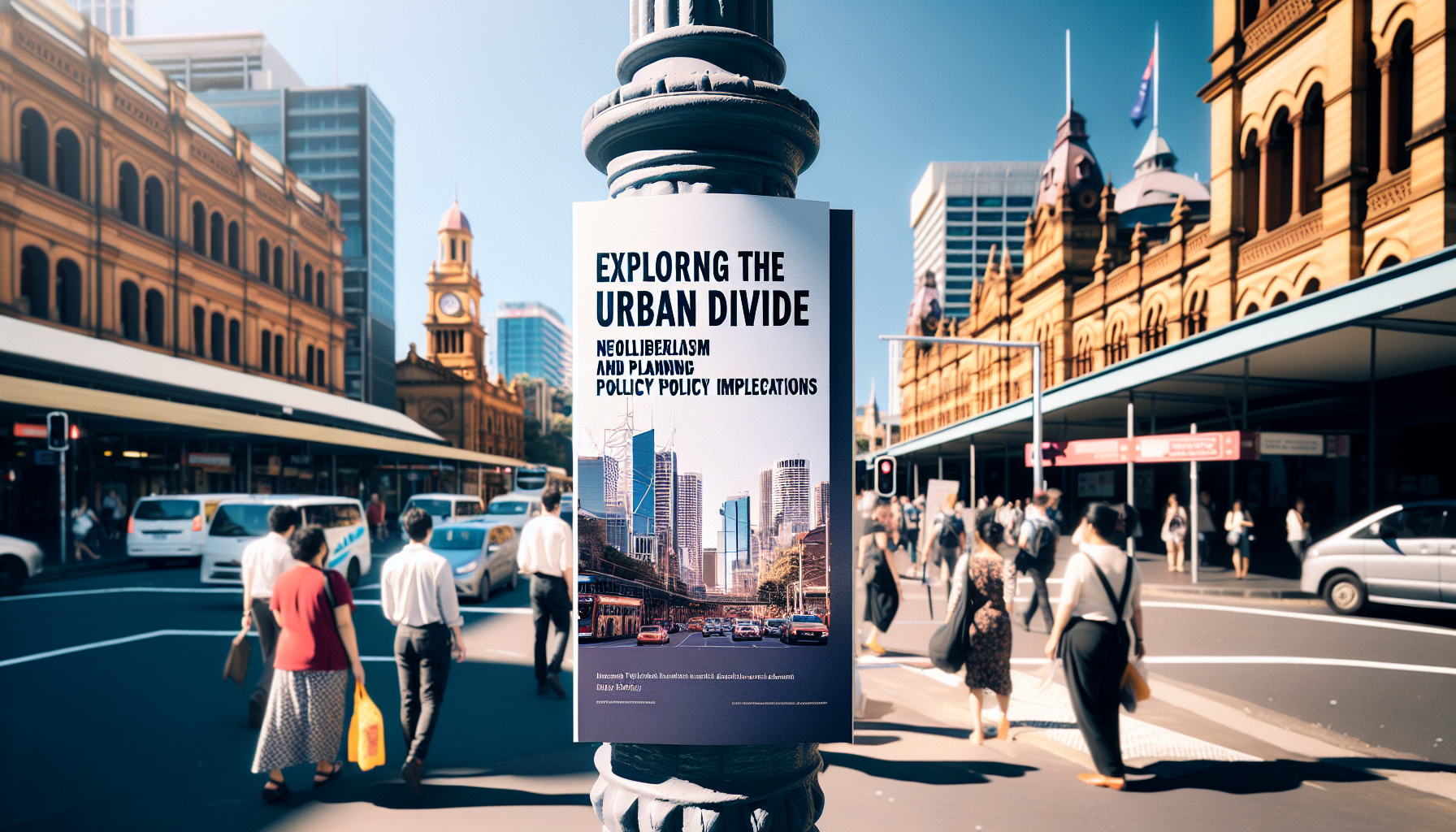 socsci-12-00083.pdf socsci-12-00083.pdfExploring the Urban Divide: Neoliberalism and Planning Policy Implications in Sydney's Local Governance
Date of Original Article: 06/02/2023
Keywords: Urban Planning, Neoliberalism, Local Government, Policy, Sydney, Socio-economic Inequality, Urban Divide
This summary provides an overview of the academic article by Farid Uddin and Piracha, which examines the socio-economic division in Sydney, Australia, through the lens of urban planning. The study hypothesises that the urban planning system and its practice-produced consequences promote inequalities in Sydney. The research is grounded in the critical concepts of neoliberalism, the theory of power, and the right to the city, and is based on semi-structured interviews, secondary documents, and data analysis. The paper underscores the importance of a just city and robust community engagement to mitigate the disparate urban policy practices influencing urban divides in Sydney. Read More
Policy Implications for Local Government
The article highlights the need for local government policy professionals to consider the impact of neoliberal urban planning on socio-economic disparities. It suggests that policy reforms have been enacted to ensure market interests, often at the expense of public participation and equitable urban development. The study points to the concentration of new housing developments in Western Sydney, which has led to a geographic and socio-economic divide within the city. Local government officials are encouraged to balance the distribution of jobs and address the ‘journey to work’ problems by considering the implications of housing and population targets set by strategic plans.
Urban Planning and Socio-Economic Disparities
The research indicates that the NSW urban planning system has been restructured to favour economic growth, often sidelining the needs of underprivileged regions. The findings suggest that the planning system generates place-based inequities and reinforces pre-existing divisions by concentrating most new dwellings in Western Sydney. This has implications for local government practice, as it calls for a more equitable distribution of urban opportunities and a critical examination of urban planning roles in addressing socio-economic disparities.
Neoliberal Urbanity and Local Governance
Local government policy professionals must recognise the influence of neoliberalism on urban planning and its role in shaping socio-economic conditions. The study’s findings imply that neoliberal urbanism commodifies urban growth and generates complications in public political action, which can lead to weaker community engagement and housing approval processes that favour market interests over public needs.
Conclusion
The article by Farid Uddin and Piracha provides valuable insights into the urban divide in Sydney and the critical role of urban planning in shaping socio-economic disparities. It calls for local government policy professionals to critically assess and address the implications of neoliberal urban planning practices to foster a more equitable and just city.
Reference:
Farid Uddin, K., & Piracha, A. (2023). Neoliberalism, Power, and Right to the City and the Urban Divide in Sydney, Australia. Social Sciences, 12(83). https://doi.org/10.3390/socsci1202008 |
|
 informit.874160178549109.pdf informit.874160178549109.pdfExploring the Impact of Integrated Planning and Reporting Reforms on Local Governance in Australia
Date of Original Article: 20/12/2022
Keywords: Integrated Planning and Reporting, Local Government, Policy Reform, Community Engagement, Strategic Planning, Australia
This summary examines the transformative effects of Integrated Planning and Reporting (IP&R) reforms on local governance in Australia. It highlights the shift towards community-centric decision-making and the potential for these reforms to be scaled up to a national level. The IP&R framework has empowered local communities to actively participate in shaping their future, ensuring that their voices are central to the strategic planning process. Read More
Policy Implications for Local Government Practice
The IP&R reforms have significant implications for local government practice. They necessitate a collaborative approach to strategic planning, involving extensive community input. This has led to a more democratic and accountable system where local governments must engage with their communities in good faith to develop Community Strategic Plans (CSPs) that reflect the collective vision for the future.
Community Engagement and Empowerment
Community engagement is at the heart of the IP&R reforms. The process requires local governments to facilitate dialogue with residents, businesses, and interest groups to identify their long-term aspirations. This engagement ensures that the strategic plans developed are genuinely reflective of community needs and desires.
Financial Sustainability and Accountability
The IP&R framework also includes a focus on long-term financial planning, which is integral to the sustainability of local government initiatives. By aligning community aspirations with financial capabilities, local governments can create more realistic and achievable plans. Additionally, the emphasis on reporting provides a mechanism for communities to monitor progress and hold their elected officials accountable.
Scaling Up to National Level
The success of IP&R at the local level has prompted discussions about its applicability at the national level. The potential for a National IP&R framework to enhance democratic engagement and improve the quality of federal decision-making is being explored. This could lead to a more participatory form of democracy, where the community has a greater say in national economic and policy decisions.
Reference:
Kelly, Bronwyn. (2022). Local governments can show national governments how to plan better: integrated planning and reporting reforms in Australia. Commonwealth Journal of Local Governance, 27, 170-180. https://doi.org/10.5130/cjlg.vi27.825 |
|
 Making global local Global methods local planning and the importance of genuine community engagement in Australia.pdf Making global local Global methods local planning and the importance of genuine community engagement in Australia.pdfEnhancing Local Governance: Strategic Cultural Planning and Authentic Community Engagement in Australia
Date of Original Article: 12/11/2022
Keywords: Local Government, Community Engagement, Cultural Planning, Co-Design, Policy Design, Strategic Planning, Public Value
This summary examines the innovative approach taken by Port Macquarie-Hastings Council in New South Wales, Australia, to develop their new Cultural Plan amidst the challenges posed by COVID-19 restrictions. The council's initiative, which is a legislative requirement for strategic planning with documented community engagement, serves as a case study for the application of global design methods in local planning contexts. The research combines a modified Design Thinking model, Co-Design Principles, and the Harvard Kennedy School's Public Policy Design Arc to explore the potential for enhancing the capacity of council staff and community representatives in strategic planning and genuine community engagement. Read More
Key Policy Implications
The study highlights the importance of incorporating community voices in the strategic planning process, ensuring that local government actions align with the aspirations and needs of the community. It also underscores the need for local governments to adopt flexible and inclusive design methods that can accommodate diverse perspectives and facilitate meaningful participation. The findings suggest that such an approach can lead to more effective and democratically legitimate policy outcomes.
Methodology and Framework
The Social is the Thing (SITT) Model developed in this study integrates three distinct but complementary design approaches to create a robust framework for community engagement. These include the principles of Co-Design, which emphasise power-sharing and relationship-building; the Creative Citizen Project (CCP) Model, which adds a reflective dimension to the Design Thinking process; and the Public Policy Design Arc, which focuses on the alignment of technical, political, and organisational aspects of policymaking.
Application and Outcomes
The application of the SITT Model in the development of the Port Macquarie-Hastings Cultural Plan involved collaborative workshops with council staff and community representatives. The process facilitated a shared understanding of the challenges and opportunities in cultural planning, leading to a strategic document that reflects the community’s vision for cultural development. Feedback from participants indicated a positive response to the co-design process and an appreciation for the skills and insights gained.
Conclusion and Reflections
The study concludes that the SITT Model offers a valuable framework for local governments to engage communities in strategic planning. By fostering genuine collaboration and leveraging design thinking, local governments can create policies that resonate with the public and enhance the democratic process. The research also points to the potential for this model to be adapted and applied in other local government contexts.
Reference:
Wahlin, W., & Blomkamp, E. (2022). Making global local: Global methods, local planning, and the importance of genuine community engagement in Australia. Policy Design and Practice, 5(4), 483-503. DOI: 10.1080/25741292.2022.214148 |
|
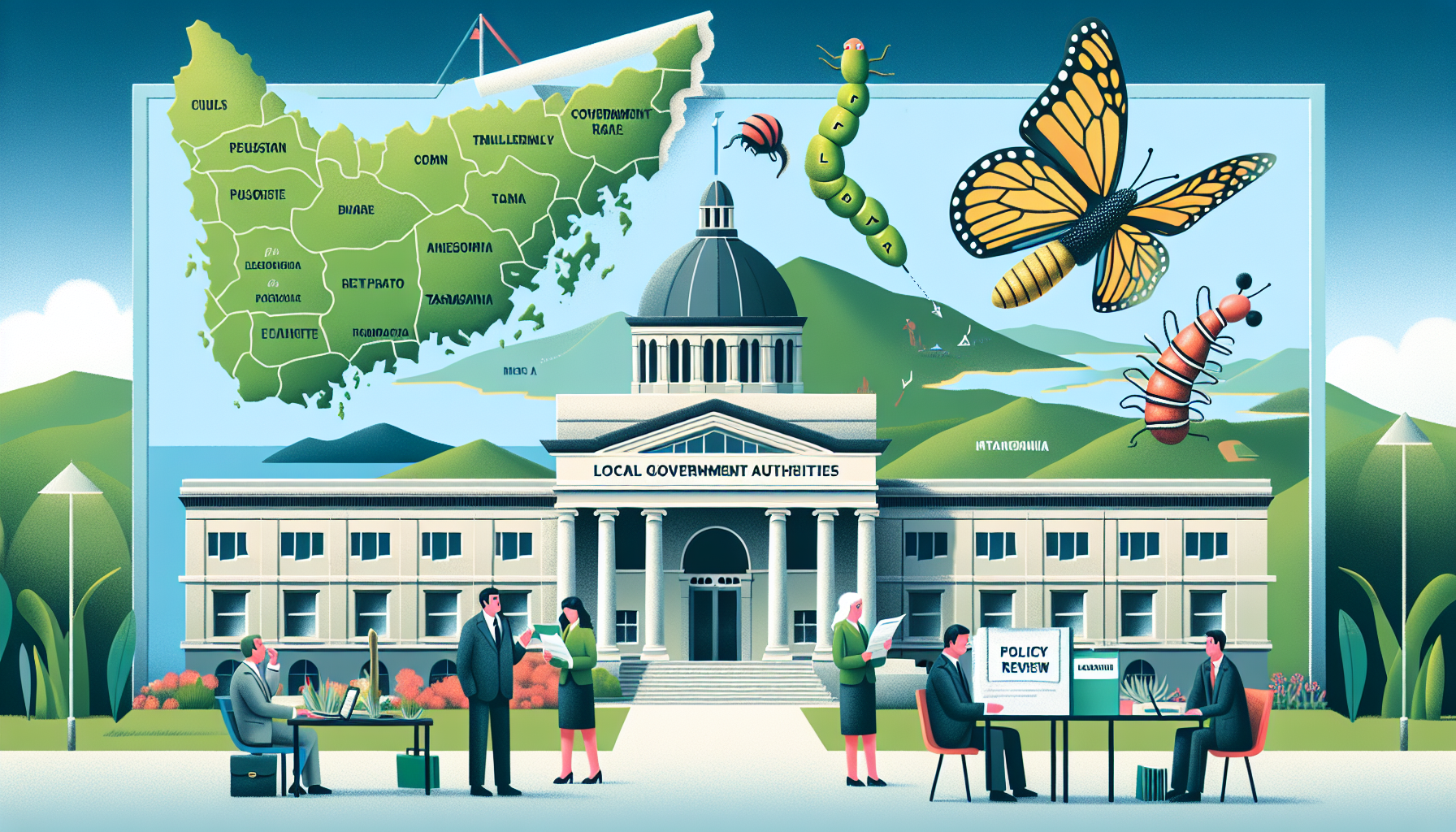 FoLGR-UTas-Paper-3-Place-shaping-and-the-future-role-of-local-government-in-Tasmania.pdf FoLGR-UTas-Paper-3-Place-shaping-and-the-future-role-of-local-government-in-Tasmania.pdfExploring Place-Shaping and the Evolving Role of Local Government in Tasmania: A Policy Review for Practitioners
Date of Original Article: 01/06/2022
Keywords: Local Government, Place-Shaping, Policy Review, Tasmania, Community Development, Local Democracy, Service Delivery
The Tasmanian Policy Exchange has produced a comprehensive report examining the concept of place-shaping and its implications for the future role of local government in Tasmania. This report delves into the significance of place in the context of rapid social, economic, and technological changes, highlighting the potential for local government to play a pivotal role in fostering strong, connected, and sustainable communities. It underscores the importance of local government in responding to diverse community needs and suggests that councils can serve as central figures in community-focused, place-shaping processes. Read More
Policy Implications for Local Government Practice
The report identifies several key policy implications for local government in Tasmania, including the need for councils to adapt to changing community roles, shifting economic pressures, and evolving local needs. It emphasises the importance of place-based approaches in rejuvenating democracy and addressing social and economic challenges. The report also explores the potential for local government to support community engagement, build community capital, and revitalise local democracy through more representative and accountable governance.
Service Delivery and Strategic Planning
Local government is positioned to deliver distinctive place-based services, which can be more effective when designed and implemented with local knowledge and community input. The report suggests that local government should continue to play a significant role in delivering critical services and infrastructure, particularly in regional communities where they may act as providers of last resort.
Representation and Advocacy
The report highlights the emerging role of local government in providing local representation within partnerships and regional governance structures. It advocates for a collaborative approach to public sector reform, where local government can act as a local anchor institution for future place-based initiatives.
Conclusion and Recommendations
The report concludes with recommendations for the Future of Local Government Review to consider the implications of a systematic place-making agenda. It calls for a realignment of council activities, resources, and personnel towards an expanded place-shaping role, with the ultimate aim of building community capital and aligning fragmented services and policies to meet local needs and promote long-term prosperity and wellbeing.
Reference:
Tasmanian Policy Exchange. (2022). Place shaping and the future role of local government in Tasmania: evidence and options. University of Tasmania |
|
 Building Community Engagement Capacity - Summary_0.pdf Building Community Engagement Capacity - Summary_0.pdfEnhancing Local Government Community Engagement Practices in Oregon
Date of Original Article: 01/06/2022
Keywords: Local Government, Community Engagement, Policy Development, Capacity Building, Oregon
This summary presents the findings of a study focused on the methods employed by local governments in Oregon to enhance their capacity for community engagement. The research encompasses a comprehensive literature review, interviews with over thirty government staff, elected officials, and practitioners, and an analysis of various community engagement practices. The study aims to identify the activities, skills, and organisational capacities that are being developed at the local level to implement and sustain effective community engagement programs.
Read More
Policy Implications and Local Government Practice
The study reveals that local governments across Oregon are actively engaging in community involvement, with a growing recognition of the importance of diversity, equity, and inclusion (DEI) in these efforts. The research highlights the need for more support in community engagement initiatives and suggests that local governments can benefit from a wider inclusion of community voices in the public process. It also notes that community engagement is a rapidly evolving field, with local governments facing new challenges due to changing demographics.
A key finding is that local governments have diverse needs, which necessitates tailored training and consultation to suit each jurisdiction’s unique circumstances. While formal training is beneficial, it is not the primary means of capacity building. Instead, peer sharing, mentoring, conferences, professional networks, community relationships, lived experience, and other informal learning sources play a significant role. Consistent leadership support and resource investment are crucial for building and sustaining community engagement capacity.
The study also identifies potential partnerships between rural governments and public universities, as well as opportunities for support from state and federal governments. It suggests that a descriptive database of organisations offering support to local governments could be developed to facilitate capacity building in community engagement.
Reference:
Greenway, G., Leistner, P., Brown, G., & Wedding, M. (2022). Building Local Government Capacity for Community Engagement: A Survey of the Field of Practice in Oregon. June 2022.
|
|
 s12961-022-00850-1.pdf s12961-022-00850-1.pdfEnhancing Local Government and Health Sector Collaboration: Insights from South Western Sydney
Date of Original Article: 20/04/2022
Keywords: Local Government, Public Health, Collaboration, Urban Planning, Health Equity, Policy Development, Qualitative Study
This summary outlines the findings of a qualitative study aimed at improving the effectiveness of collaboration between local governments and the public health sector, specifically the South Western Sydney Local Health District (SWSLHD) and local councils. The study highlights the need for evidence-informed actions to address health inequities and the potential value of partnerships in achieving overlapping goals of both sectors. Read More
Key Policy Implications
The study underscores the importance of providing locally relevant public health data to local councils. This data is crucial for addressing mutual concerns and enhancing the consultation process. The findings suggest that proactive and ongoing consultation between SWSLHD and councils is vital for effective engagement and coordinated action. The insights gained from this study are applicable to other councils beyond the SWSLHD, reflecting broader challenges and opportunities in local government settings across Victoria, South Australia, and New South Wales.
Strategies for Effective Collaboration
Effective collaboration requires the provision of evidence-based local data to inform strategic decision-making. Councils express a need for high-quality, local-level data to enable prioritisation in budget allocation and policy development. Additionally, aligning the goals of SWSLHD with those of local councils can lead to more integrated and health-promoting urban planning initiatives. Regular, proactive communication between health districts and councils is also identified as a key enabler for successful partnerships.
Conclusion
The study concludes that a strong collaborative partnership between public health professionals and local government is essential for addressing health inequities through structural interventions, such as changes to the built environment. The findings advocate for a more proactive role by local health districts in engaging with councils, providing evidence-based data, and fostering ongoing communication to enhance the health outcomes of communities.
Reference:
Kovai, V., Mahjabeen, Z., Jalaludin, B., & Fox, F. (2022). Towards an effective collaboration between the South Western Sydney Local Health District and local councils: insights from a qualitative study. Health Research Policy and Systems, 20(47). https://doi.org/10.1186/s12961-022-00850- |
|
 Governance and Sustainability in Local Government.pdf Governance and Sustainability in Local Government.pdfEnhancing Governance and Sustainability in Local Government: Insights from Victoria's Legislative Reforms
Date of Original Article: 12/04/2022
Keywords: Local Government, Governance, Sustainability, ESG, Ethics, Culture, Policy, Victoria, Legislation, Accountability
The academic article by Armstrong & Li examines the challenges faced by local government councils in Victoria, Australia, as highlighted by the Victorian Auditor General's Office (VAGO) Reports 2021. These challenges include conflicts of interest, manipulation of land deals, and a lack of independence, leading to the introduction of the Local Government Act 2020 (VIC). The article discusses the implications of this new legislation for governance, risk management, accountability, organisational culture, leadership, and community engagement within local councils. It also explores the balance of economic, environmental, social, and governance (ESG) concerns in creating sustainable governance structures that meet community needs. Read More
Policy Implications for Local Government Practice
The Local Government Act 2020 (VIC) represents a significant shift in the strategic planning and reporting arrangements for local councils. It emphasises community vision, outcomes focus, community engagement, and additional planning requirements. The Act mandates councils to engage with their communities and respond to their aspirations, ensuring long-term sustainable thinking is at the core of policy and strategy development.
Furthermore, the Act introduces stronger accountability and transparency mechanisms, including a Code of Conduct for councillors and an expanded reporting framework. Councils are now required to develop consultation mechanisms and incorporate these into a policy, fostering a culture of genuine engagement with the community.
Challenges in Sustainable Governance
Local governments are at the forefront of addressing ESG issues, with the responsibility to deliver services that contribute to the well-being of their communities. The paper underscores the importance of sustainable governance practices that do not compromise the ability of future generations to meet their needs. It highlights the role of local governments in climate action and protecting communities from the impacts of climate change.
The article also points out the need for local councils to manage risks effectively, including economic, financial, health, safety, and environmental risks. Good governance practices, as proposed by the Municipal Association of Victoria (MAV) and VAGO, support risk management policies and practices, including the formal and annual assessment of leaders and monitoring of performance with appropriate measures.
Building a Positive Organisational Culture
The culture of an organisation is shaped by its leadership and governance structures. The Local Government Act 2020 (VIC) aims to improve the culture within local government councils by setting clearer standards of behaviour and stronger mechanisms to address poor conduct. The article emphasises the need for councils to be responsible and accountable for the culture of their organisations, which includes promoting values such as integrity, teamwork, respect, and professionalism.
Reference:
Armstrong, A. & Li, Y. (2022). Governance and Sustainability in Local Government. Australasian Accounting, Business and Finance Journal, 16(2), 12-22 |
|
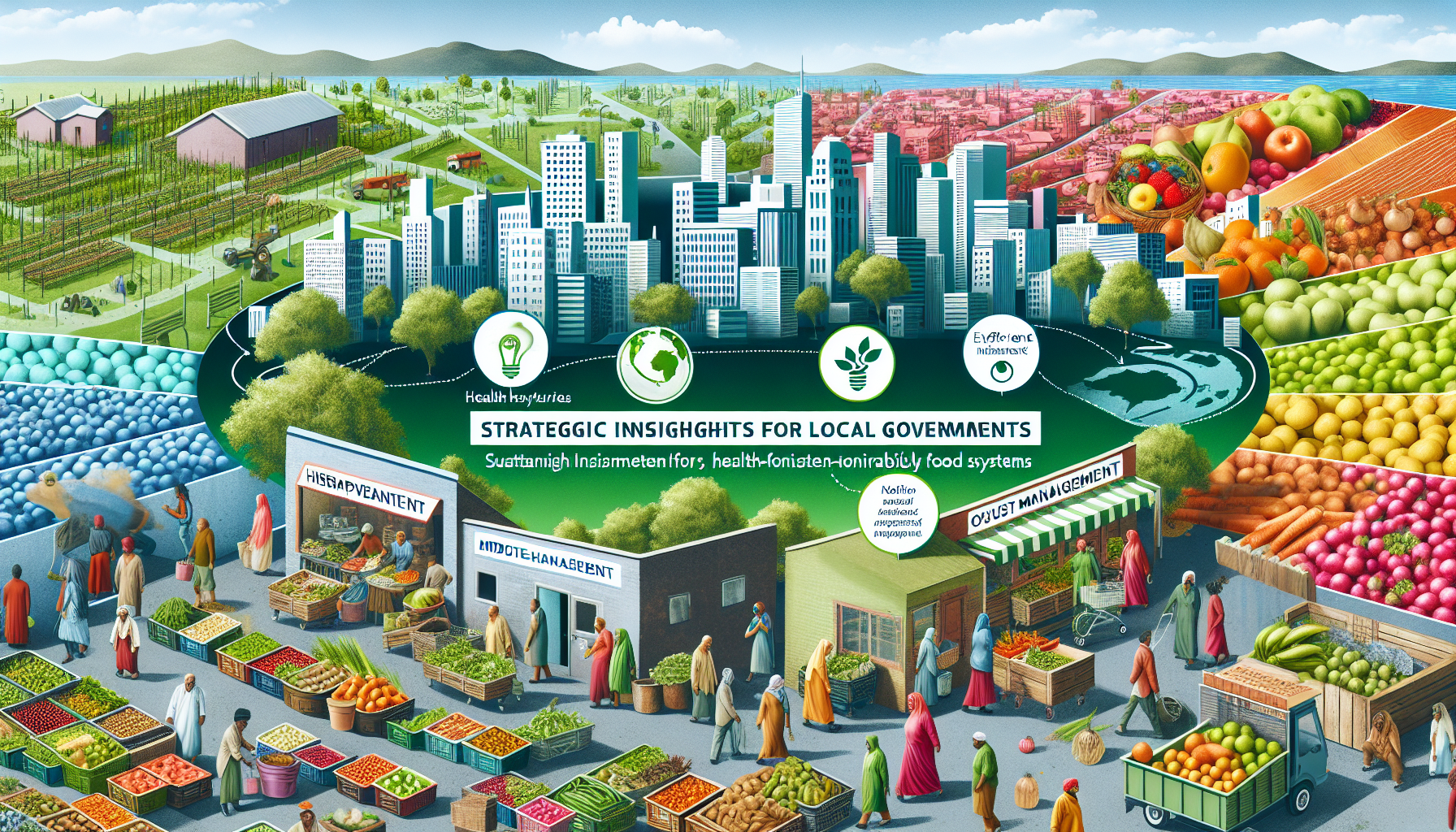 November event report_final.pdf November event report_final.pdfStrategic Insights for Local Government: Fostering Healthy, Sustainable, and Equitable Food Systems
Date of Original Article: 19/11/2021
Keywords: Local Government, Food Systems, Policy, Sustainability, Health Equity, Community Engagement, Strategic Planning
This summary synthesises the findings from a workshop titled "Healthy, sustainable, equitable food systems: The role of local government," which focused on the role of Australian local governments in creating robust food systems. The workshop highlighted the challenges and opportunities faced by local governments in New South Wales and Victoria, drawing on policy mapping studies and case analyses. The discussions centred on barriers to action, enablers of success, and practical steps for local governments to enhance their food system policies. Read More
Policy Implications and Barriers
Local governments encounter several barriers when addressing food system issues, including the absence of a state or federal mandate, limited funding, and internal governance challenges. The lack of a cohesive national policy framework and state-level support hinders local government action, while planning frameworks often prioritise development interests over food system sustainability. Internal challenges within local governments, such as bureaucracy and departmental silos, further complicate efforts to implement effective food system policies.
Enablers of Local Government Action
Key enablers for local government action include leadership from within the community and council, effective framing of food system issues, and cross-departmental collaboration. Partnerships with external stakeholders, such as community groups and businesses, are also crucial. Additionally, funding and innovative opportunities can drive progress in local food system policies.
Next Steps for Local Governments
Local governments seeking to advance their food system policies should leverage existing resources, increase internal and regional collaboration, and engage more deeply with their communities. Including food systems in strategic planning and policy-making is essential, as is the formalisation of food system commitments within local government operations.
Supports Needed for Local Government Action
Enhanced state-level support, including legislative mandates and funding, would significantly strengthen local government initiatives. Building internal capacity and food systems literacy, along with improved data for policy-making, are also identified as critical needs. Further opportunities for collaboration, such as Food Policy Councils, could provide a platform for diverse stakeholders to contribute to food system decision-making.
Reference:
Carrad, A., Turner, L., Rose, N., Charlton, K.E., Reeve, B. (2022). The role of Australian local governments in creating a healthy, sustainable, and equitable food system: Discussion themes from the workshop, Healthy, sustainable, equitable food systems: The role of local government. Sydney, NSW: University of Sydney |
|
 Policy Internet - 2022 - Randell‐Moon - Too smart Infrastructuring the Internet through regional and rural smart policy.pdf Policy Internet - 2022 - Randell‐Moon - Too smart Infrastructuring the Internet through regional and rural smart policy.pdfEnhancing Regional Connectivity: Smart Policy for Rural and Local Government in Australia
Date of Original Article: 07/10/2021
Keywords: Smart Infrastructure, Local Government, Regional Development, Internet Policy, Rural Connectivity, First Nations
This summary provides an overview of an academic article that examines the role of smart infrastructure in the liveability and viability of rural and regional towns in Australia. The study focuses on the Internet infrastructure and smart policy development in North West New South Wales, highlighting the experiences of local stakeholders, including shire councillors, land councillors, and consumers. The research reveals that regional and rural communities often face exclusion from the evidence base for smart technologies and services, and that local Aboriginal Land Councils play a crucial role in managing digital processes across different Countries. Read More
Policy Implications for Local Government
The article underscores the importance of smart infrastructure investment in regional areas, as outlined in the Australian Government’s Smart Cities Plan and Regional Connectivity Program. It also discusses the New South Wales Government’s emphasis on connectivity and telecommunications infrastructure development through the Regional Digital Connectivity program. However, the findings indicate that smart regional policy is inconsistently applied, with some areas lacking comprehensive strategies or relying on piecemeal approaches.
Local government professionals should note the critical need for equitable Internet infrastructure to support regional growth and development. The study suggests that without significant investment in telecommunications infrastructure equality, achieving Internet parity with metropolitan cities remains a challenge. This has implications for attracting businesses, supporting local economies, and enhancing the quality of life for residents in regional and rural areas.
Regional and Rural Growth through Smart Development
The research highlights that regional and rural understandings of growth are experienced through the infrastructuring processes of Internet quality, availability, and speed. The quality of telecommunications infrastructure is perceived to impact liveability and growth significantly. Local governments are encouraged to advocate for reliable network availability and to address the disparities in service provision that can hinder regional development.
First Nations and Local Aboriginal Land Councils
The involvement of First Nations and Local Aboriginal Land Councils is crucial for smart regional development. The study points out that these councils are often overlooked in policy and literature within Australia, despite their significant role in managing digital processes and contributing to regional planning. Local governments should engage with these councils to ensure that smart policies are inclusive and consider the needs of First Nations communities.
Conclusion
Local government policy professionals must recognise the importance of smart infrastructure in supporting the liveability and viability of rural and regional towns. The study calls for a more inclusive approach to smart policy development that takes into account the unique challenges faced by regional and rural communities, as well as the pivotal role of First Nations in shaping these policies.
Reference:
Randell-Moon, H. E. K., & Hynes, D. (2022). Too smart: Infrastructuring the Internet through regional and rural smart policy in Australia. Policy & Internet, 14, 151-169. https://doi.org/10.1002/poi3.28 |
|
 mayo2021.pdf mayo2021.pdfOptimising Local Governance: Navigating Community Engagement in Times of Uncertainty
Date of Original Article: 01/06/2021
Keywords: Local Governance, Community Engagement, Postnormal Times, Policy Implications, Digital Engagement, Polylogues
This summary examines the collaborative research project between the Sunshine Coast Council (SCC) and the University of the Sunshine Coast (USC), which explores innovative approaches to community engagement within the context of postnormal times. The study investigates the concept of polylogues as a means to navigate uncertainty and the role of local governance in facilitating these complex, multi-stakeholder conversations. The research is particularly relevant in light of the disruptions caused by the COVID-19 pandemic, which has necessitated a pivot towards digital engagement strategies. Read More
Key Policy Implications for Local Government Practice
The research underscores the importance of local governments in leading community engagement efforts during periods of significant global change. It highlights the need for nontraditional forms of engagement that extend beyond legislative requirements, aiming to amplify community values and envision alternative futures. The study suggests that local governance structures can operationalize polylogues, fostering diverse and inclusive dialogues that contribute to community resilience and social capital.
Furthermore, the research identifies the challenges posed by the digital transformation of community engagement. It calls for local governments to adapt to the changing landscape of subjectivity, where residents increasingly inhabit both physical and digital spaces. This shift necessitates a re-evaluation of traditional engagement methods to ensure they remain effective in capturing the evolving identities and preferences of community members.
Conclusion and Future Directions
The preliminary findings from the #CovidKindness campaign demonstrate the potential of digital platforms to reach and engage communities effectively during crises. However, the research also acknowledges the need for further investigation into how digital engagement can sustain meaningful connections and support collaborative community actions post-crisis. The study concludes with a call for local governments to embrace innovative engagement strategies that are responsive to the complexities of postnormal times and the fluid nature of community identity.
Reference:
Mayo, L., Osborne, C., Bussey, M., & Burns, T. (2021). Engaging Communities Through Uncertainty: Exploring the Role of Local Governance as a Way of Facilitating Postnormal Polylogues. World Futures, 77(4), 245-265. DOI: 10.1080/02604027.2021.192978 |
|
 osborne2021.pdf osborne2021.pdfTransformative Community Engagement: A New Model for Local Government Excellence
Date of Original Article: 25/05/2021
Keywords: Community Engagement, Local Government, Place-Based Approaches, Futures Studies, Partnership, Policy Implications
In an era of rapid societal changes and growing public expectations, local governments are tasked with the challenge of maintaining relevance and trust within their communities. This article summary explores the innovative community engagement practices developed by a local government organisation in collaboration with a regional university in Queensland, Australia. The emerging model is grounded in place-based approaches and futures studies, aiming to co-design locally appropriate responses to navigate uncertainty and change. The summary outlines the key policy implications for local government practice, focusing on the integration of community insights into decision-making processes and the development of a transformative model of excellence in engagement. Read More
Policy Implications for Local Government Practice
The article highlights the necessity for local governments to engage communities meaningfully and collaboratively to maintain legitimacy and trust. It underscores the importance of incorporating diverse community perspectives into policy-making and the potential of place-based and futures thinking approaches to strengthen social and economic potential. The case study demonstrates the value of university-community partnerships in fostering innovative engagement practices and co-creating transformative place-based futures.
Developing a Transformative Engagement Model
The research agenda proposed in the article focuses on creating a model of excellence in engagement that leverages the strengths of local government and higher education institutions. This model emphasises the co-creation of shared value, the development of social capital, and the enhancement of community dialogue around issues that matter. It also seeks to build local capacity and leadership through a place-based approach, addressing complex social issues and fostering a culture of innovation and participation.
Methodological Approach and Findings
The article’s methodological approach involved a comprehensive literature review and the identification of gaps in university-community engagement literature, particularly in the context of local government. The findings reveal a need for long-term vision and commitment, relationship building, trust, inclusivity, and multi-stakeholder collaboration. The proposed model aims to be innovative, scalable, transformative, measurable, and effective in addressing the unique challenges and opportunities of local communities.
Conclusion and Future Directions
The article concludes with a call for local governments to adopt innovative and participatory methods for community engagement. It suggests that the integration of futures studies with place-based approaches can provide valuable insights and tools for reimagining community futures. The partnership between Sunshine Coast Council and the University of the Sunshine Coast serves as a promising example of how collaborative efforts can lead to the development of a transformative model of excellence in engagement.
Reference:
Osborne, C., Mayo, L., & Bussey, M. (2021). New frontiers in local government community engagement: Towards transformative place-based futures. Futures, 131, 102768. https://doi.org/10.1016/j.futures.2021.10276 |
|
 Local Government Capacity and Land Use Planning for Natural Hazards A Comparative Evaluation of Australian Local Government Areas.pdf Local Government Capacity and Land Use Planning for Natural Hazards A Comparative Evaluation of Australian Local Government Areas.pdfEnhancing Local Government Land Use Planning for Natural Hazards: Insights from Australian LGA Comparative Study
Date of Original Article: 04/05/2021
Keywords: Local Government, Land Use Planning, Natural Hazards, Comparative Evaluation, Australian Local Government Areas, Policy Implications
This summary provides an overview of a study that evaluates the capacity of Australian Local Government Areas (LGAs) to incorporate land use planning for natural hazards. The research conducted by James McGregor, Melissa Parsons, and Sonya Glavac assesses the effectiveness of local governments in mitigating risks associated with natural hazards through planning practices. The findings highlight the varying levels of preparedness and planning across different LGAs, offering valuable insights for policy professionals seeking to enhance local government strategies in this critical area. Read More
Key Findings and Policy Implications
The study reveals significant disparities in the capacity of LGAs to manage land use planning for natural hazards. It suggests that local governments must prioritise the integration of hazard mitigation into land use planning to reduce vulnerability and enhance community resilience. The research underscores the need for tailored approaches that consider the unique characteristics and risk profiles of each LGA.
Policy professionals are encouraged to leverage the study’s comparative evaluation to identify best practices and areas for improvement within their own jurisdictions. The study’s insights can inform the development of robust frameworks and policies that support LGAs in effectively managing natural hazard risks through strategic land use planning.
Reference:
McGregor, J., Parsons, M., & Glavac, S. (2022). Local Government Capacity and Land Use Planning for Natural Hazards: A Comparative Evaluation of Australian Local Government Areas. Planning Practice & Research, 37(2), 248-268. DOI: 10.1080/02697459.2021.191943 |
|
 Aust J Public Adm - 2021 - Hirst - Western Australia s Local Government Act 25 years on and under review A qualitative.pdf Aust J Public Adm - 2021 - Hirst - Western Australia s Local Government Act 25 years on and under review A qualitative.pdfExploring the Impact of Western Australia's Local Government Act on CEO Job Security and Policy Practice
Date of Original Article: 17/01/2021
Keywords: Local Government, Policy Reform, CEO Job Security, Councillor Training, Public Sector, Western Australia
This summary provides an analysis of the qualitative study conducted on the perceptions of Chief Executive Officers (CEOs) within Western Australian local governments regarding the Local Government Act 1995 (WA). The study highlights the significant impact of the Act on the roles and responsibilities of local government CEOs, councillors, and the community. It also offers practical recommendations for legislative changes to improve the functioning of local governments and address the concerns raised by the CEOs. Read More
Key Policy Implications for Local Government Practice
State-Local Government Interface
The study identifies a need for a process to manage persistent complainants who place undue pressure on local governments. CEOs suggest the introduction of an external body to review and moderate such complaints, which would allow local governments to legitimately refuse further correspondence with aggrieved residents or groups without accusations of non-responsiveness.
CEO and Councillor Interface
CEOs express concerns over job insecurity, primarily due to their legislative requirement to report councillors for suspected legislative breaches while being dependent on these councillors for employment. The study recommends a structural shift in local government CEO employment from local councils to the state government to mitigate this conflict of interest.
Additional issues include the length of CEO employment contracts, severance payments, councillors’ lack of skills in human resource management, lack of role clarity for councillors regarding responsibility for CEO workplace safety, and lack of oversight over Council as an employer. To address these, the study suggests mandatory training for councillors in community engagement and strategy development, as well as legislative changes to clarify the councillor role and responsibilities.
Councillor-Community Interface
The lack of clarity in the legislation regarding the councillor role leads to role tension and inefficiencies. The study calls for legislative specifications on whether councillors’ responsibilities include lodging service requests on behalf of community members and, if so, ensuring that such requests are brought through official council meetings.
Reference:
Hirst, T. M., Carpini, J. A., Timming, A. R., & Notebaert, L. (2021). Western Australia’s Local Government Act 25 years on and under review: A qualitative study of local government Chief Executive Officers. Australian Journal of Public Administration, 80, 809-829. https://doi.org/10.1111/1467-8500.1246 |
|
 informit.751560913860288.pdf informit.751560913860288.pdfExploring Recent Trends in Australian Local Government Reform: Implications for Policy Professionals
Date of Original Article: 23/12/2020
Keywords: Local Government Reform, Policy Implications, Australian Municipalities, Governance, Structural Reform, Financial Management, Accountability, Regional Cooperation
The article by Graham Sansom, published in the Commonwealth Journal of Local Governance, examines the ongoing reforms within Australian local government, focusing on the period post-2013. It identifies six key themes: structural reform and regional cooperation, principles-based local government acts, roles and responsibilities of elected officials, revenue controls, financial and performance auditing, and integrity and accountability. The paper provides insights into the shift from structural reforms to a more nuanced approach that emphasises good governance, democratic accountability, and the strengthening of regional cooperation. It also discusses the implications of these reforms for local government practice and policy. Read More
Policy Implications and Local Government Practice
The article highlights several areas where recent reforms have significant implications for local government policy professionals:
Structural Reform and Regional Cooperation
While structural reforms, such as municipal mergers, have been a central focus in the past, there is now a shift towards enhancing regional cooperation. This includes the creation of Joint Organisations in New South Wales and the promotion of collaborative regional authorities in Western Australia.
Principles-Based Local Government Acts
Revised local government acts are moving towards a principles-based approach, complementing the power of general competence available to municipalities. This shift aims to provide overarching principles for good governance while reducing detailed prescription.
Roles and Responsibilities of Elected Officials
Amendments to local government acts are clarifying the roles and responsibilities of mayors and councillors, reinforcing their democratic prerogatives and shifting the balance of power towards elected officials.
Revenue Controls
States impose various controls on local government revenue-raising capabilities, such as rate-pegging or rate-capping. These controls have significant implications for the financial autonomy and service delivery capacity of local governments.
Financial and Performance Auditing
There is an increased focus on both external and internal audits, with state Auditors General playing a more prominent role in financial and performance audits. Internal audit processes are also being strengthened, with a trend towards establishing expert audit committees with independent members.
Integrity and Accountability
States are implementing measures to address misconduct, fraud, and corruption within local government. This includes updated codes of conduct, improved complaint handling mechanisms, and additional powers for state intervention.
Reference:
Sansom, G. (2020). Recent trends in Australian local government reform. Commonwealth Journal of Local Governance, 23, 7546. DOI: https://doi.org/10.5130/cjlg.vi23.754 |
|
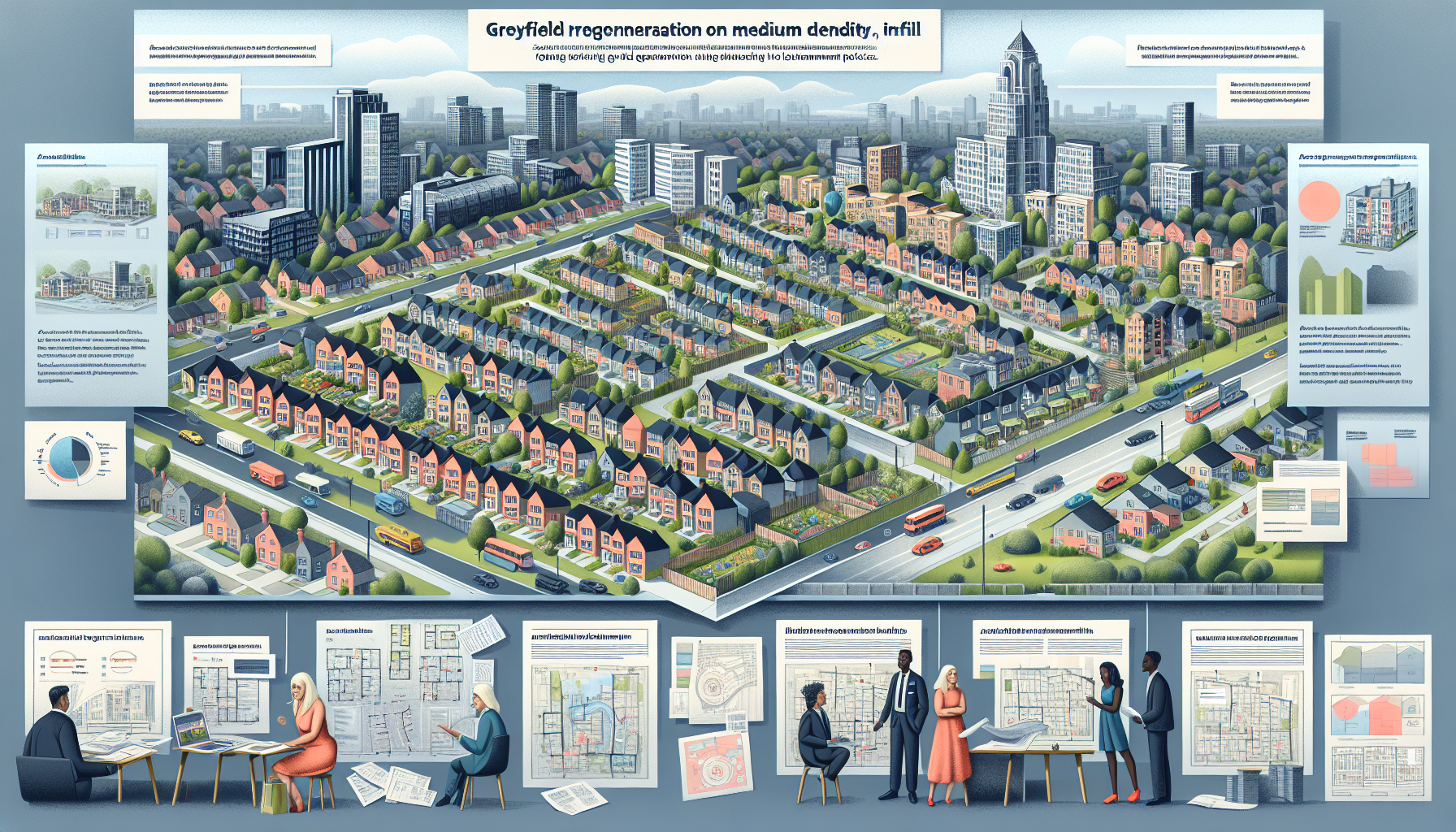 newton2020.pdf newton2020.pdfStrategies for Greyfield Regeneration: Medium Density Infill in Local Government Policy
Date of Original Article: 27/09/2020
Keywords: Greyfield Suburbs, Medium Density Residential Infill, Local Government Policy, Urban Regeneration, Municipality-Initiated Development, Resident-Supported Precincts
This article examines the shift towards municipality-initiated and resident-supported medium density residential infill regeneration in greyfield suburbs. It highlights the limitations of small lot subdivisions and proposes a more strategic approach to urban renewal that aligns with local government policy objectives. Read More
Policy Implications for Local Government
The research suggests that local governments should take a proactive role in the regeneration of greyfield areas. By initiating precinct-scale developments, municipalities can better manage the transition to medium density housing, ensuring that it meets the needs of both current and future residents. This approach also allows for the integration of sustainable urban design principles and the provision of necessary infrastructure and services.
Resident Involvement in Urban Renewal
The involvement of existing residents is crucial for the success of regeneration projects. The article advocates for a collaborative process where local governments engage with communities to gain support and input. This participatory approach can lead to more equitable outcomes and a sense of ownership among residents, which is essential for the long-term sustainability of the developments.
Challenges and Opportunities
While the benefits of medium density infill are clear, the article acknowledges the challenges faced by local governments, including funding constraints, regulatory hurdles, and potential resistance from residents. However, it also identifies opportunities for innovation in policy and practice that can overcome these barriers and lead to successful regeneration projects.
Reference:
Peter Newton, Stephen Glackin, Jennifer Witheridge & Lisa Garner (2020): Beyond small lot subdivision: towards municipality-initiated and resident-supported precinct scale medium density residential infill regeneration in greyfield suburbs., Urban Policy and Research, DOI: 10.1080/08111146.2020.181518 |
|
 59723972.pdf 59723972.pdfIntegrating Arts and Innovation: Policy Implications for Local Government in Geraldton's Creative Ecosystem
Date of Original Article: 19/05/2020
Keywords: Local Government Policy, Arts and Culture Strategy, Economic Development, Community Engagement, Arts Entrepreneurship, Cultural Tourism, Digital Connectivity, Regional Development, Public Funding, Innovation Ecosystem
The academic article provides an in-depth analysis of Geraldton, Western Australia's arts and culture ecosystem, highlighting its unique integration of arts, culture, and economic development. The city's strategic approach to arts funding, community engagement, and innovative business models for artists is examined, alongside the implications for local government policy and practice. The summary delves into the key characteristics of Geraldton's arts and culture scene, the role of public funding, and the interplay between arts and innovation, particularly through the local incubator, Pollinators. It also discusses the challenges faced by the arts community and the potential for cultural tourism as a driver of economic growth. Read More
Key Policy Implications for Local Government Practice
Public Funding and Strategic Vision
Geraldton’s arts and culture ecosystem benefits from a strong publicly-funded arts and cultural strategy, integrating social, cultural, and economic objectives. Local government policy professionals should consider the importance of clear rationales for funding and the impact of such strategies on community development and economic diversification.
Community Engagement and Volunteerism
The extensive ecosystem of pro-am and volunteer arts and cultural workers in Geraldton underscores the value of community engagement in arts and culture. Policies that support and facilitate volunteerism can enhance the vibrancy and sustainability of local arts scenes.
Arts Entrepreneurship and Business Innovation
Geraldton’s arts entrepreneurship and innovative business models for artists, particularly through the work of Pollinators, demonstrate the potential for arts and culture to contribute to the innovation ecosystem. Local governments can foster this interconnection by supporting mixed-sector start-up facilitators and encouraging creative business models.
Cultural Tourism and Economic Growth
The increase in tourism, including cultural tourism experiences, highlights the potential for arts and culture to drive economic growth. Local government policies that enhance cultural amenities, improve hospitality and accommodation options, and develop secondary offerings can attract tourists and support the local economy.
Digital Connectivity and Regional Development
Geraldton’s status as one of the first Fibre-to-the-Premises (FTTP) sites in regional Australia, coupled with high-speed digital connectivity, positions it as a leader in digital strategy. Local governments can leverage such infrastructure to support the digital workforce and regional development.
Challenges and Opportunities for Arts and Culture
Managing generational change in institutional and leadership structures, developing local Aboriginal arts enterprises, and overcoming town-planning barriers are among the challenges faced by Geraldton’s arts and culture sector. Addressing these challenges through targeted policies and support can further strengthen the community’s cultural ecosystem.
Reference:
Hearn, G., McCutcheon, M., Ryan, M., D. & Cunningham, S. (2020). Australian Cultural and Creative Activity: A Population and Hotspot Analysis: Geraldton. Brisbane. Digital Media Research Centre. Available https://research.qut.edu.au/creativehotspots/wp-content/uploads/sites/258/2020/05/Geraldton-report-FINAL-v2-20200519.pd |
|
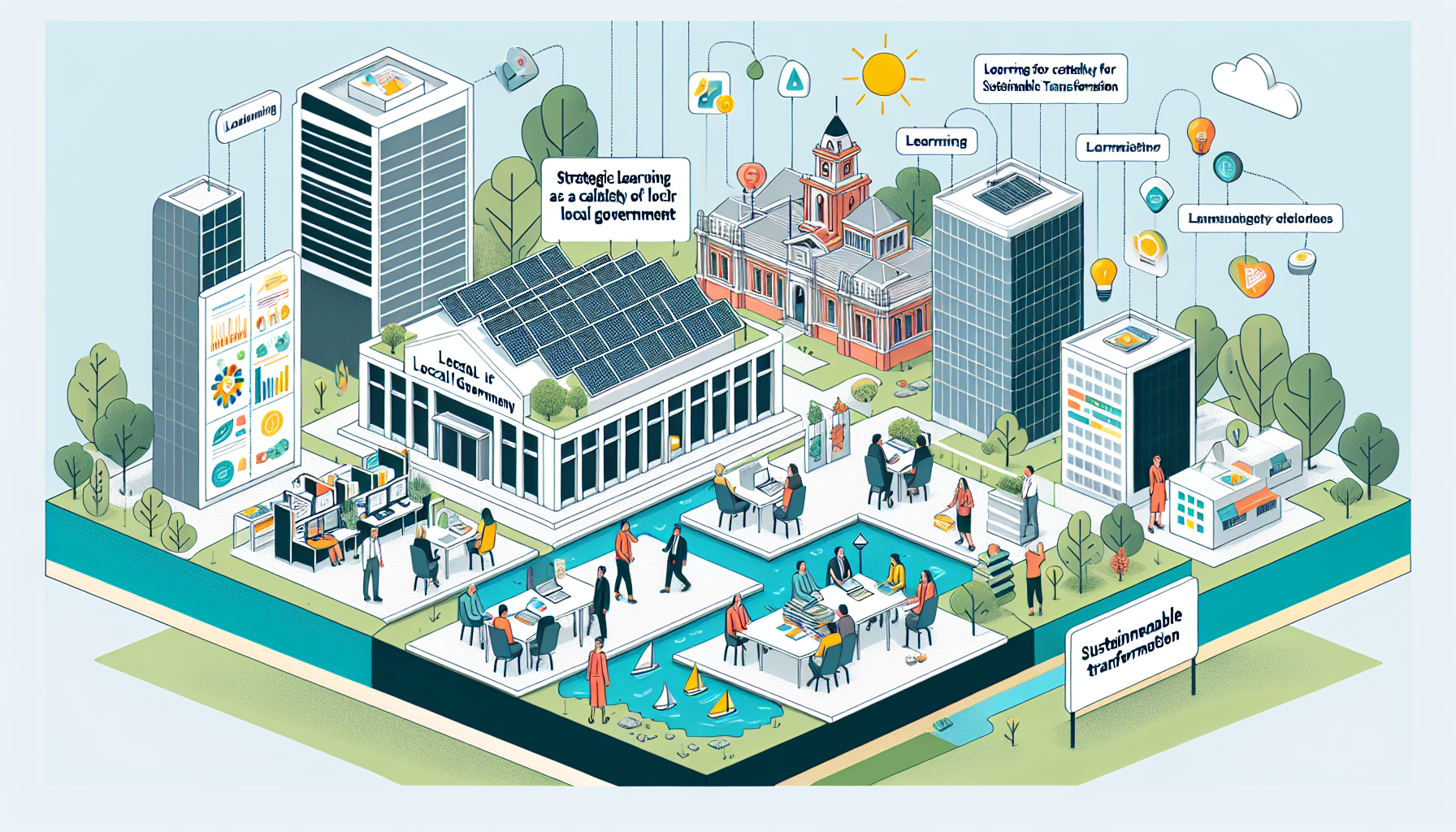 s11625-020-00808-8.pdf s11625-020-00808-8.pdfStrategic Learning as a Catalyst for Sustainable Transformation in Local Government: A Perth Case Study
Date of Original Article: 30/04/2020
Keywords: Sustainability, Local Government, Organisational Change, Education for Sustainable Development, Policy Innovation, Leadership
This summary provides an insight into the transformative role of strategic learning in embedding sustainability within a local government context, as evidenced by a case study from Perth, Western Australia. The longitudinal study, conducted between 2011 and 2016, explores the introduction of a sustainability policy and an education and culture change program within the City of Canning's local government. The case study highlights the significance of learning as a leverage point for achieving systemic sustainability change and offers a detailed account of the methods and impacts of the program, including the development of internal champions and the creation of a sustainability policy. Read More
Policy Implications and Local Government Practice
The case study underscores the importance of strategic sustainability approaches in local government operations. It demonstrates how a sustainability policy, underpinned by the Framework for Strategic Sustainable Development (FSSD), can guide decision-making and integrate sustainability into core organisational processes. The study also emphasises the value of education in fostering a shared understanding of sustainability concepts, enabling cross-departmental collaboration and empowering staff to become agents of change within their spheres of influence.
Key Steps in the Change Process
The change process within the City of Canning involved several key steps, including the mobilisation of internal actors, the development of a sustainability policy, the implementation of an education program, and the initiation of sustainability projects. These steps were facilitated by the support of leadership, the creation of a dedicated sustainability facilitator role, and the establishment of a network of sustainability champions across the organisation.
Outcomes and Impact
The education program, based on the FSSD, was instrumental in creating a common language and understanding of sustainability, which in turn led to the development of departmental sustainability action plans and a range of sustainability initiatives. The case study provides tangible examples of outcomes, such as increased staff capacity to implement sustainability projects and the amplification of sustainability impact through trained staff members acting as champions within their departments.
Conclusion
The City of Canning’s experience illustrates the potential for strategic learning to serve as a key leverage point for sustainability transformations within local government. The case study offers valuable lessons for other local governments seeking to integrate sustainability into their operations and culture, highlighting the importance of policy, education, and the empowerment of staff as critical components of successful sustainability programs.
Reference:
Bryant, J., & Thomson, G. (2021). Learning as a key leverage point for sustainability transformations: a case study of a local government in Perth, Western Australia. Sustainability Science, 16, 795-807. https://doi.org/10.1007/s11625-020-00808-8 |
|
 Accountable to who to whom for what and how_ Unpacking Accounta.pdf Accountable to who to whom for what and how_ Unpacking Accounta.pdfExploring Accountability in Local Government Climate Policy: Implications and Challenges
Date of Original Article: 14/03/2020
Keywords: Local Government, Climate Change Response, Accountability, Policy Implications, Environmental Governance
This summary provides an overview of an academic article that examines the role of local government in addressing climate change through the lens of accountability. The study investigates the complex dynamics of who is accountable, to whom they are accountable, for what they are accountable, and how accountability is enacted within the context of local government responses to climate change. The findings highlight the influence of community demands, political cycles, and internal organisational structures on the level of accountability observed in local councils. The research contributes to the understanding of organisational initiatives in climate response and underscores the challenges faced by local governments in being accountable for environmental actions. Read More
Key Policy Implications
The study’s findings have significant implications for local government practice, particularly in the development and implementation of climate change policies. The unclear roles and responsibilities within councils, coupled with the varying commitment levels of leaders, underscore the need for clearer governance structures and mandates for climate action. The influence of community demands and socioeconomic factors on council decisions suggests that public engagement strategies should be refined to balance immediate local concerns with long-term environmental objectives. Additionally, the reliance on third-party stakeholders and consultants indicates a potential gap in internal expertise that could be addressed through targeted capacity building and training.
Accountability Dynamics in Local Government
Accountability within local governments is highly contextual, with external pressures from the community and political cycles playing a significant role. Internally, a hierarchical chain of command and collaboration among council workers shape the accountability landscape. The study reveals that while strategic documents may outline environmental commitments, the specificity and prioritisation of climate change initiatives vary, leading to challenges in defining and measuring accountability for climate response.
Conclusion and Recommendations
The research suggests that local governments face a complex set of challenges in being accountable for climate change response. To enhance accountability, local governments should consider establishing clear roles and responsibilities, improving community engagement on climate issues, and integrating climate change more explicitly into strategic planning and performance measurement. Further research is needed to explore the effectiveness of different accountability mechanisms and to develop best practices for embedding climate change initiatives within local government operations.
Reference:
Quayle, B., Sciulli, N., & Wilson-Evered, E. (2020). Accountable to who, to whom, for what and how? Unpacking accountability in local government response to climate change. Australasian Accounting, Business and Finance Journal, 14(3), 56-74. doi: 10.14453/aabfj.v14i3. |
|
 savini2020.pdf savini2020.pdfEnhancing Participatory Governance: Assessing Deliberative Engagement Reforms in Victoria's Local Government
Date of Original Article: 03/03/2020
Keywords: Deliberative Democracy, Local Government Reform, Participatory Governance, Victoria, Policy Implications
This summary examines the Victorian state government's attempt to legislate mandatory deliberative engagement within local government strategic planning. Despite the reform's ambition, it faced near-unanimous rejection from the local government sector. The analysis delves into the submissions from the 3-year Victorian Local Government Act Review process, highlighting the limitations and barriers to implementing such practices at the local government level. The findings suggest that while the concept of participatory democracy is appealing, there were significant contextual and capacity considerations that impeded the reform's implementation in Victoria. Read More
Policy Implications for Local Government Practice
The proposed legislative reforms aimed to institutionalise participatory and deliberative democracy within local government operations. However, the submissions from local governments revealed a lack of consensus on the benefits of deliberative engagement, concerns over the resources required, and a need for clarity on the reform’s intentions. These factors underscore the importance of shared understanding and agreement on the development of participatory practices, as well as the organisational capacity to execute new engagement methods.
Understanding Community Expectations
Submissions highlighted a discrepancy between the community’s desire for involvement in decision-making and the practicality of their engagement in local government processes. The community’s motivation to engage often centred on specific urban planning issues, with a call for greater transparency and accountability. This indicates a need for local governments to clarify the scope of community influence in decision-making and to manage expectations regarding the outcomes of participatory processes.
Building Consensus on Deliberative Engagement
The local government sector’s response to the proposed reforms was predominantly negative, with many councils arguing against prescriptive legislation on community engagement. The lack of a clear definition of ‘deliberative engagement’ and the existing accountability measures were cited as reasons for their opposition. This suggests that any future reforms should involve extensive consultation with local governments to ensure a shared understanding of the terms and objectives of participatory governance.
Addressing Organisational Capacity
Concerns about the resources and capacity required to implement deliberative engagement practices were prevalent in the submissions. Local governments expressed apprehension about the potential strain on their resources and the feasibility of meeting the reform’s requirements. This highlights the need for state governments to consider the practical implications of such reforms on local government operations and to provide adequate support for their implementation.
Reference:
Savini, E., & Grant, B. (2020). Legislating deliberative engagement: Is local government in Victoria willing and able? Australian Journal of Public Administration, 79(3), 514-530. doi:10.1111/1467-8500.1242 |
|
 ielapa.980099992532245.pdf ielapa.980099992532245.pdfEnhancing Local Government Emergency Preparedness: Evaluating Community Engagement Strategies
Date of Original Article: 01/01/2020
Keywords: Local Government, Emergency Management, Community Engagement, Policy Implications, Evaluation, Preparedness
This summary examines the critical role of community engagement in emergency management and the challenges faced by local government policy professionals in evaluating the effectiveness of such initiatives. The original article, based on a presentation at AFAC19, highlights the importance of helping communities recognise and prepare for natural hazards, a task that has become increasingly imperative in light of recent unprecedented summer temperatures and damaging bushfires in Australia. The study explores the current evaluation methods employed by community engagement practitioners and managers from Australian emergency management organisations, councils, and not-for-profit organisations, and suggests that while the importance of measuring engagement efforts is recognised, there is a lack of linkage between engagement activities and higher-level outcomes that influence communities. Read More
Key Policy Implications
The article underscores the potential for local governments to measure community engagement in a more meaningful way, moving beyond headcounts and event attendance to include social or economic modelling approaches. These approaches could evaluate the direct impacts of community engagement on health outcomes, lives saved, and economic and social indicators. The findings indicate that most community engagement teams do not link their activities with strategic objectives, pointing to a need for a culture of evaluation within organisations and a strategic approach to community engagement.
Enhancing Evaluation Practices
Local government policy professionals are encouraged to develop a culture of evaluation and to establish clear strategic connections to community engagement functions. This involves setting SMART objectives for community engagement and conducting baseline research to measure achievements effectively. The study also highlights the need for adaptable, scalable evaluation tools to assist practitioners in undertaking meaningful evaluation.
Conclusion and Recommendations
The article concludes that standardisation of evaluation and monitoring practice would support the resourcing and reporting of community engagement outcomes. It recommends that future preparedness and recovery doctrine for the sector should support measurement and evaluation. Additionally, it suggests that local government teams should ensure they have the necessary skills and commitment to evaluation as part of their community engagement strategy.
Reference:
Taylor, M., Ryan, B., & Johnston, K. A. (2020). The missing link in emergency management: evaluating community engagement. Australian Journal of Emergency Management, 35(1), 45-51 |
|
 dowling2019.pdf dowling2019.pdfExploring the Evolution of Smart City Strategies in Sydney and Melbourne: A Comparative Analysis
Date of Original Article: 21/11/2019
Keywords: Smart City, Local Government Policy, Urban Technology, Sydney, Melbourne, Strategic Urban Planning
This summary examines the development and implementation of smart city initiatives in Sydney and Melbourne, focusing on the role of local governments in shaping the urban landscape through technology. The original article by Dowling, McGuirk, and Gillon (2019) provides an in-depth analysis of how smart city concepts are being operationalised within these metropolitan areas, highlighting the prevalence of piecemeal initiatives over comprehensive strategies. The study underscores the incremental transformation of cities and governance through smart urbanism, rather than radical overhauls. Read More
Key Policy Implications
The research reveals that local governments are at the forefront of integrating smart technologies into urban management, with a significant number of councils engaging in smart initiatives. However, the adoption of these technologies is often characterised by a lack of overarching strategic frameworks, suggesting a more ad hoc approach to smart urbanism.
Smart governance initiatives, including digital transformation of services and citizen engagement platforms, are the most common, followed by smart living, mobility, and environment projects. The presence of a formal smart city strategy appears to influence the complexity and coordination of initiatives, with more sophisticated projects like open data platforms being more prevalent in councils with established strategies.
The study also highlights the diversity of smart technologies being deployed, ranging from digital infrastructure and sensor networks to mobile applications and open data platforms. The distribution of these technologies suggests that while strategic planning can enhance the scope and impact of smart initiatives, many councils are successfully implementing smart solutions without a formalised strategy.
For policy professionals, the findings emphasise the importance of considering local contexts and challenges when adopting smart technologies. The piecemeal nature of current initiatives indicates a need for greater strategic coordination to maximise the benefits of smart urbanism. Additionally, the research points to the potential for smart city strategies to play a pivotal role in urban governance and economic development.
Reference:
Dowling, R., McGuirk, P., & Gillon, C. (2019). Strategic or Piecemeal? Smart City Initiatives in Sydney and Melbourne. Urban Policy and Research. DOI: 10.1080/08111146.2019.167464 |
|
 christensen2019.pdf christensen2019.pdfExploring the Commercialisation of Community Engagement in Local Government: Implications for Democracy
Date of Original Article: 19/11/2019
Keywords: Local Government, Community Engagement, Commercialisation, Participatory Governance, Policy Implications, Australian Local Democracy
The article by Helen E. Christensen & Bligh Grant examines the emerging trend of commercialising community engagement within Australian local governments. It highlights the increasing legislative requirements for councils to engage with their communities and the subsequent rise of an industry providing engagement services. The paper explores the potential risks this commercialisation poses to local governance and democracy, and calls for a deeper understanding of its impacts. Read More
Policy Implications for Local Government Practice
The commercialisation of community engagement presents several policy implications for local government professionals. The trend towards outsourcing engagement activities to private providers raises questions about the integrity and effectiveness of participatory processes. Local governments must consider the balance between legislative compliance, community expectations, and the influence of market-driven engagement strategies.
Policy professionals should be aware of the standardisation risk associated with commercialised engagement practices. The use of common frameworks and tools may lead to a homogenisation of engagement processes, potentially stifling local innovation and responsiveness to community needs.
Furthermore, the reliance on external providers could impact the development of internal capacities within councils. Local government policy professionals must evaluate the long-term implications of diminished in-house expertise in community engagement and consider strategies to maintain and enhance internal competencies.
Conclusion and Recommendations
In conclusion, while the commercialisation of community engagement services offers potential benefits in terms of efficiency and expertise, it also poses significant challenges to the ethos of local democracy. Policy professionals in local government are encouraged to critically assess the role of commercial providers in engagement processes and to ensure that the democratic values of transparency, inclusivity, and accountability remain at the forefront of community participation initiatives.
Reference:
Christensen, H. E., & Grant, B. (2019). Outsourcing local democracy? Evidence for and implications of the commercialisation of community engagement in Australian local government. Australian Journal of Political Science, DOI: 10.1080/10361146.2019.1689921 |
|
 Robba_2019_IOP_Conf._Ser.__Earth_Environ._Sci._344_012015.pdf Robba_2019_IOP_Conf._Ser.__Earth_Environ._Sci._344_012015.pdfEnhancing Local Government Policy through Art and Science: The Painted River Project's Role in Cultural Transformation and Community Engagement
Date of Original Article: 01/08/2019
Keywords: Local Government Policy, Community Engagement, Cultural Transformation, Environmental Science, Water Resource Management, Art and Science Collaboration
The Painted River Project (PRP) represents an innovative approach to community engagement, combining art and environmental science to foster a cultural transformation in the perception and stewardship of river systems. This initiative aims to deepen the understanding of the critical role that water and river systems play in human health, well-being, and the health of the planet. By actively involving the community in participatory art-making and scientific water testing, the PRP explores the shared connection to water and place, offering tangible ways to address complex environmental challenges and prompting action towards sustainable solutions. Read More
Policy Implications for Local Government Practice
The PRP provides a model for local governments to engage with diverse communities in a meaningful way, transcending language barriers and traditional forms of consultation. The project’s participatory nature allows for the collection of a wide range of perspectives, fostering inclusivity in decision-making processes. By integrating community-generated art into strategic planning, local governments can enhance place-making initiatives and promote a sense of collective responsibility for environmental stewardship. The PRP aligns with the United Nations Sustainable Development Goals, particularly those related to clean water, health and well-being, and sustainable communities, offering a blueprint for local policy development.
Community Engagement and Cultural Shifts
The PRP’s success in Western Sydney’s Duck River area demonstrates the potential for art to break down barriers to participation and normalise environmental advocacy. The project’s outcomes have informed Cumberland Council’s strategic plan for the river’s rehabilitation, highlighting the importance of community vision in shaping policy. The PRP’s framework, grounded in Planetary Health principles, emphasises the interconnectedness of human activity, ecosystem health, and the need for a cultural shift towards sustainability.
Design Thinking and Planetary Health
Employing design thinking methodologies, the PRP fosters transformative thinking and collaborative problem-solving. This human-centred approach encourages diverse participation and inclusivity, essential for addressing the multifaceted challenges of planetary health. The project’s structure, informed by design thinking’s five phases—discovery, interpretation, ideation, experimentation, and evolution—guides communities in visualising a sustainable future for their local waterways.
Reference:
Robba, L., & Wright, I. A. (2019). The painted river project: Art meets science communicating cultural transformation through community engagement. IOP Conference Series: Earth and Environmental Science, 344, 012015. IOP Publishing. doi:10.1088/1755-1315/344/1/01201 |
|
 kelly2019.pdf kelly2019.pdfStrategic Coastal Management in Local Government: Navigating Policy and Practice in NSW
Date of Original Article: 13/05/2019
Keywords: Coastal Management, Local Government Policy, Strategic Planning, Environmental Law, New South Wales, Australia
This summary examines the evolving legal and policy framework for coastal management in New South Wales (NSW), Australia, with a focus on the role of local government. It highlights the transition from traditional land-use planning to strategic approaches in addressing both existing and future coastal damage. The paper underscores the need for local government planners to adopt more dynamic and innovative strategies, moving beyond restrictive zoning mechanisms. It also emphasises the importance of collaboration across all levels of government, recognising that regulatory planning alone is insufficient to tackle the complexities of coastal damage. Read More
Policy Implications for Local Government
The paper suggests that local governments must become more proactive and strategic in their approach to coastal management. This involves considering the potential for planned retreat, engaging with coastal engineering experts, and ensuring that local environmental plans (LEPs) and development control plans (DCPs) are tailored to address the unique challenges posed by coastal damage. The introduction of the Coastal Management Act 2016 (CM Act) and the State Environmental Planning Policy (Coastal Management) 2018 (SEPP CM) provides a more comprehensive framework for councils to manage coastal risks, including the requirement to develop Coastal Management Programs (CM Programs).
Strategic Planning and Regulatory Framework
The paper critiques the traditional zoning-focused planning system, advocating for a more flexible and strategic approach that can adapt to local conditions. It highlights the potential for councils to incorporate climate change adaptation measures into their planning instruments, such as the LEPs and DCPs. The SEPP CM is praised for its comprehensive approach to climate change adaptation, which could serve as a model for more strategic planning at the local level.
Financial and Technical Support for Local Government
Recognising the financial constraints faced by local governments, the paper notes the availability of state funding to support the development and implementation of CM Programs. This financial assistance is crucial for councils to effectively manage coastal hazards and implement actions identified in their CM Programs.
Conclusion
The paper concludes that while the statutory planning system in NSW has its limitations, there is scope for local government to play a pivotal role in coastal management. By embracing strategic planning and utilising the tools provided by the CM Act and SEPP CM, councils can better protect coastal communities and environments from the impacts of coastal damage.
Reference:
Kelly, A. H., Brown, J., & Strickland, A. (2020). Local government and coastal damage: confusion, potential and dreams. Journal of Property, Planning and Environmental Law, 12(1), 1-18. DOI: 10.1108/JPPEL-10-2018-003 |
|
 10.1080@02697459.2019.1590771.pdf 10.1080@02697459.2019.1590771.pdfEnhancing Public Engagement in Local Government Planning: Insights from Australian Policy
Date of Original Article: 27/03/2019
Keywords: Local Government, Public Engagement, Strategic Planning, Policy Implications, Australia
This summary provides an analysis of public knowledge and involvement in metropolitan and local strategic planning within Australia. Despite the recognised importance of strategic planning in shaping the future of cities and regions, there is a notable gap between the public's perception of the significance of such plans and their actual awareness and involvement. This discrepancy presents a challenge for local government policy professionals aiming to enhance public engagement in the planning process. Read More
Key Policy Implications
The findings indicate that while a majority of the public deems metropolitan and local strategic plans as crucial, only a minority are informed about the specific plans that govern their areas. Homeowners, older age cohorts, and higher-income households are more likely to be aware of these plans, suggesting that financial stakes and long-term residency influence public engagement with strategic planning.
Local media, council notices, and social networks are primary sources of information for those aware of strategic plans. However, state planning departments’ direct communication channels, such as websites and newsletters, are less effective in reaching the public. This highlights the need for local government policy professionals to explore more effective strategies for disseminating information and facilitating public participation in the planning process.
Given the reliance on local sources for information, there is an opportunity for local governments to play a more proactive role in educating and involving the community. This could include leveraging social media platforms, enhancing the visibility of planning information in local media, and fostering stronger relationships with community groups.
Policy professionals should consider the socio-economic and demographic factors that influence public knowledge and engagement. Tailored approaches that address the specific needs and preferences of different community segments may improve overall public involvement in strategic planning.
Reference:
Ruming, Kristian (2019): Public Knowledge of and Involvement with Metropolitan and Local Strategic Planning in Australia, Planning Practice & Research, DOI: 10.1080/02697459.2019.159077 |
|
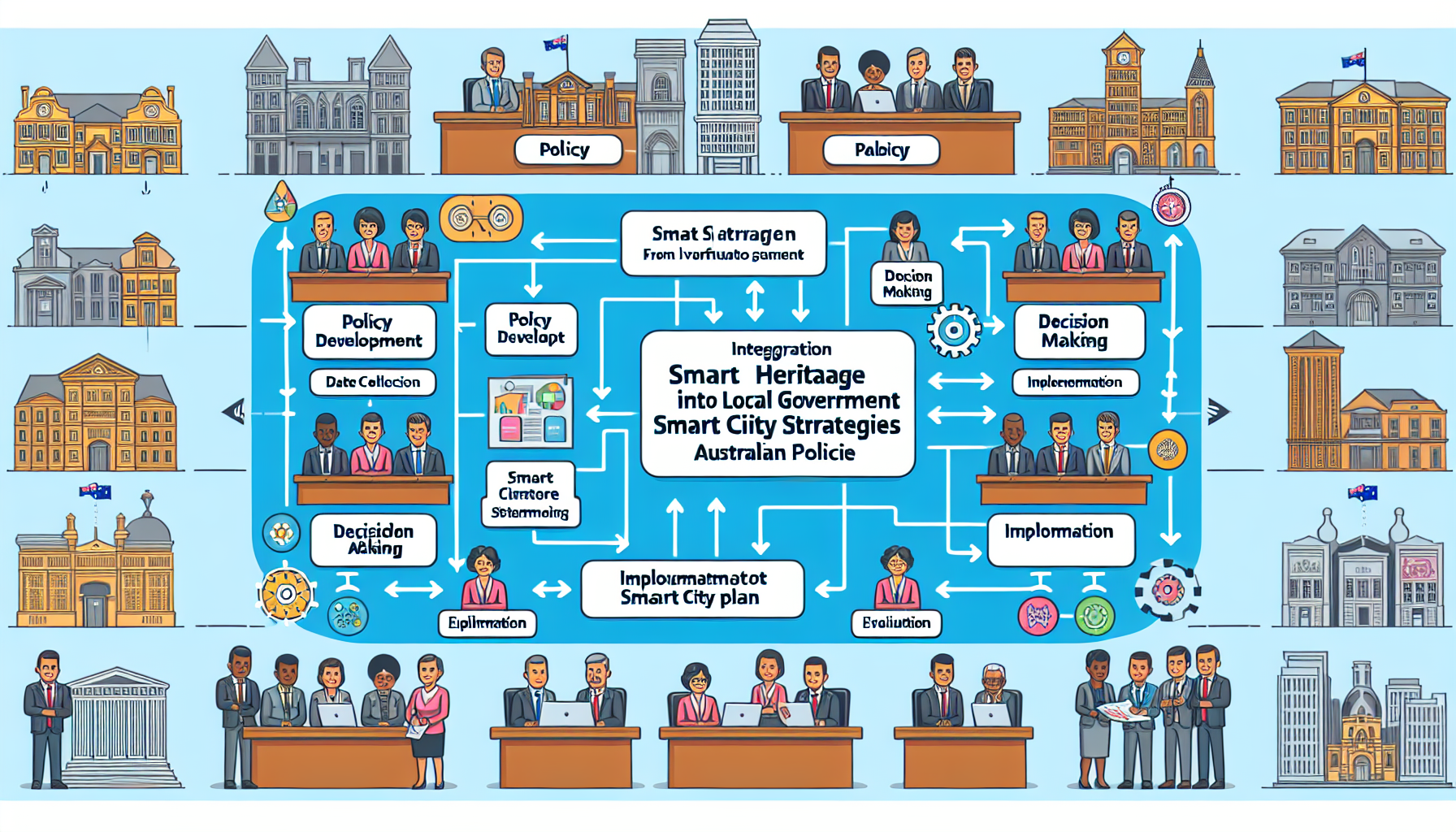 26-Smart-Heritage-in-selected-Australian-local-government-smart-city-policies.pdf 26-Smart-Heritage-in-selected-Australian-local-government-smart-city-policies.pdfIncorporating Smart Heritage into Local Government Smart City Strategies: An Analysis of Australian Policies
Date of Original Article: 01/01/2019
Keywords: Smart Heritage, Smart City, Local Government Policy, Australian Smart City Strategies, Heritage Integration
This summary examines the integration of Smart Heritage within smart city policies of three Australian local governments: Logan City Council, Lake Macquarie City Council, and Brisbane City Council. Smart Heritage, a concept that utilises the past to enhance smart city development, is subtly present in these policies, although not explicitly stated. The research identifies a need for more direct Smart Heritage provisions and initiatives, despite the theoretical overlap between the policies and the concept. The findings suggest that while Smart Heritage is not a focal point, there is potential for its further implementation within existing frameworks. Read More
Policy Implications and Integration of Smart Heritage
The analysis reveals that Smart Heritage elements are embedded within high-level definitions and objectives of the examined policies. However, there is a lack of explicit Smart Heritage-focused provisions and initiatives. The smart city definitions and objectives set by the councils shape the scope for Smart Heritage, which can either broaden or restrict its implementation. The policies tend to adopt a top-down approach, focusing on council-controlled outcomes, which may limit the scope for Smart Heritage. A more flexible approach, as seen in Brisbane’s policy, allows for a broader application of Smart Heritage across various sectors.
Recommendations for Enhancing Smart Heritage Implementation
To improve the presence of Smart Heritage in local government policies, the study suggests the following:
- Objectives should emphasise the narrative of the city and its people, guiding lower-order components without overly restricting Smart Heritage outcomes.
- Provisions should explicitly highlight concepts associated with the past and their benefits for liveability, economic growth, innovation, civic identity, and wellbeing.
- Initiatives need direct implementation to meaningfully apply Smart Heritage, such as using data analytics to create new dialogues and enrich city experiences.
Conclusion
The research concludes that while Smart Heritage is not explicitly implemented in the smart city policies of the three Australian local governments, its elements are present and there is potential for further integration. The policies share many of the same elements and outcomes with Smart Heritage, suggesting that with increased specificity and direct implementation, Smart Heritage can be more effectively incorporated into local government smart city strategies.
Reference:
Batchelor, D., & Schnabel, M. A. (2019). Smart Heritage in selected Australian local government smart city policies. In A. Agrawal & R. Gupta (Eds.), Proceedings of the 53rd International Conference of the Architectural Science Association (pp. 245-254). Architectural Science Association (ANZAScA) |
|
 s12889-021-11224-7.pdf s12889-021-11224-7.pdfStrategic Implementation of Outdoor Exercise Parks: Enhancing Physical Activity in Older Adults
Date of Original Article: 19/10/2018
Keywords: Local Government Policy, Physical Activity, Older Adults, Public Health, Urban Planning, Community Engagement
The ENJOY project, aimed at promoting physical activity and social connectedness among older adults, involved the installation of specialised outdoor exercise equipment, known as the Seniors Exercise Park, and the delivery of a physical and social activity program. This summary reflects on the collaborative process with local governments and the community, highlighting challenges, lessons learnt, and strategies for future implementation to inform local government policy professionals. Read More
Policy Implications for Local Government Practice
Local government structures and policies play a crucial role in the implementation of community health projects. Effective communication and strategic planning are essential for the successful installation and maintenance of outdoor exercise facilities designed for older adults. The ENJOY project’s experience underscores the importance of cross-departmental coordination, formal partnership agreements, and consideration of community factors such as safety and accessibility.
Challenges and Recommendations
One of the main challenges encountered was the siloed nature of local government departments, which can hinder communication and project coordination. It is recommended that early discussions involve all relevant departments to ensure a cohesive approach. Additionally, securing long-term commitment for maintenance and management is vital, akin to the provision for children’s playgrounds.
The lack of shade policy in public parks emerged as a barrier to safe outdoor activity. Advocacy for policy change and the inclusion of shade structures in urban planning are recommended to protect users from weather elements.
Research timelines and budget constraints require flexibility when collaborating with local governments. Advanced planning and a staggered approach to project execution can accommodate the lengthy internal processes of local governments.
Community engagement is crucial for the sustainability of health interventions. Involving senior ambassadors and end-users throughout the project can enhance communication and participation. Promotion strategies should be tailored to the preferences and capabilities of older adults, with a focus on accessible and relevant communication channels.
Conclusion
The ENJOY project’s collaborative research framework with local governments offers valuable insights for improving environments to promote physical activity among older people. The lessons learnt can assist in the design of public health programs and research on the built environment, ultimately impacting older adults’ physical activity levels positively.
Reference:
Levinger, P., Dunn, J., Panisset, M., Dow, B., Batchelor, F., Biddle, S. J. H., Duque, G., & Hill, K. D. (2021). Challenges and lessons learnt from the ENJOY project: recommendations for future collaborative research implementation framework with local governments for improving the environment to promote physical activity for older people. BMC Public Health, 21(1192). https://doi.org/10.1186/s12889-021-11224- |
|
 phrp3342330-december-2023-volume-33-issue-4-moving-towards-lgbtqia-inclusive-planning.pdf
phrp3342330-december-2023-volume-33-issue-4-moving-towards-lgbtqia-inclusive-planning.pdf Aust J Public Adm - 2023 - Taylor - Governing Greater Sydney The democratic promise and contention of local governments.pdf
Aust J Public Adm - 2023 - Taylor - Governing Greater Sydney The democratic promise and contention of local governments.pdf full-paper_149.pdf
full-paper_149.pdf ES-2021-12566.pdf
ES-2021-12566.pdf s12939-023-01925-3.pdf
s12939-023-01925-3.pdf Barriers and opportunities for medium density housing in small regional cities stakeholder perspectives from Cairns.pdf
Barriers and opportunities for medium density housing in small regional cities stakeholder perspectives from Cairns.pdf socsci-12-00083.pdf
socsci-12-00083.pdf informit.874160178549109.pdf
informit.874160178549109.pdf Making global local Global methods local planning and the importance of genuine community engagement in Australia.pdf
Making global local Global methods local planning and the importance of genuine community engagement in Australia.pdf FoLGR-UTas-Paper-3-Place-shaping-and-the-future-role-of-local-government-in-Tasmania.pdf
FoLGR-UTas-Paper-3-Place-shaping-and-the-future-role-of-local-government-in-Tasmania.pdf Building Community Engagement Capacity - Summary_0.pdf
Building Community Engagement Capacity - Summary_0.pdf s12961-022-00850-1.pdf
s12961-022-00850-1.pdf Governance and Sustainability in Local Government.pdf
Governance and Sustainability in Local Government.pdf November event report_final.pdf
November event report_final.pdf Policy Internet - 2022 - Randell‐Moon - Too smart Infrastructuring the Internet through regional and rural smart policy.pdf
Policy Internet - 2022 - Randell‐Moon - Too smart Infrastructuring the Internet through regional and rural smart policy.pdf mayo2021.pdf
mayo2021.pdf osborne2021.pdf
osborne2021.pdf Local Government Capacity and Land Use Planning for Natural Hazards A Comparative Evaluation of Australian Local Government Areas.pdf
Local Government Capacity and Land Use Planning for Natural Hazards A Comparative Evaluation of Australian Local Government Areas.pdf Aust J Public Adm - 2021 - Hirst - Western Australia s Local Government Act 25 years on and under review A qualitative.pdf
Aust J Public Adm - 2021 - Hirst - Western Australia s Local Government Act 25 years on and under review A qualitative.pdf informit.751560913860288.pdf
informit.751560913860288.pdf newton2020.pdf
newton2020.pdf 59723972.pdf
59723972.pdf s11625-020-00808-8.pdf
s11625-020-00808-8.pdf Accountable to who to whom for what and how_ Unpacking Accounta.pdf
Accountable to who to whom for what and how_ Unpacking Accounta.pdf savini2020.pdf
savini2020.pdf ielapa.980099992532245.pdf
ielapa.980099992532245.pdf dowling2019.pdf
dowling2019.pdf christensen2019.pdf
christensen2019.pdf Robba_2019_IOP_Conf._Ser.__Earth_Environ._Sci._344_012015.pdf
Robba_2019_IOP_Conf._Ser.__Earth_Environ._Sci._344_012015.pdf kelly2019.pdf
kelly2019.pdf 10.1080@02697459.2019.1590771.pdf
10.1080@02697459.2019.1590771.pdf 26-Smart-Heritage-in-selected-Australian-local-government-smart-city-policies.pdf
26-Smart-Heritage-in-selected-Australian-local-government-smart-city-policies.pdf s12889-021-11224-7.pdf
s12889-021-11224-7.pdf
